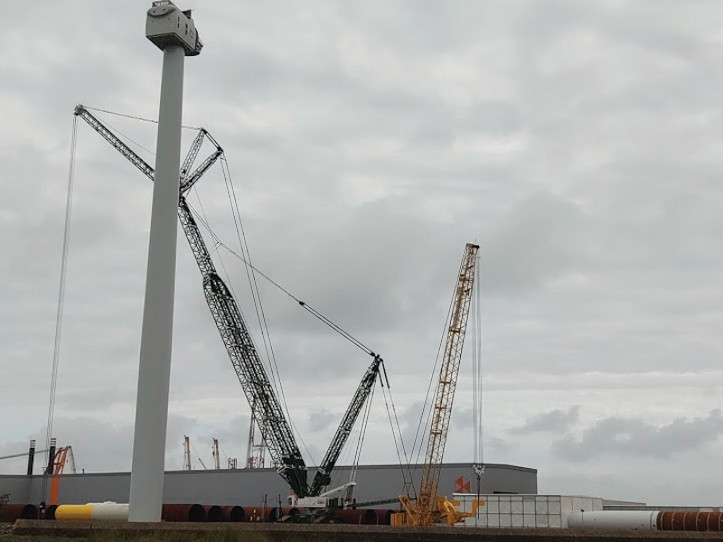Page 1: Renewables Power New Business
Page 2: Balancing Fossil Fuels and Renewables
The Port of Rotterdam is Europe’s largest. It stretches westward some 25 miles from its original 19th century site adjacent to the old city center. On reclaimed land, near that far western tip, past miles and miles of oil refineries, crackers and storage facilities and close to the port’s first fully automated terminal, towers the prototype of the world’s largest offshore wind turbine.

GE Renewable Energy finished installing its 12MW Haliade-X turbine mid-October. GE has begun to undergo stress testing on the giant windmill.
The turbine’s location is both practical and symbolic. It stands next to the 500-meters-long Sif Group factory that assembles and marshals the columns, called monopiles, used in offshore wind. On the seaside, Sif operates a 400 meters quay capable of simultaneously receiving turbine components and dispatching them to North Sea wind parks. When the port was visited recently, jackup vessels were anchored, ready to pick up the monopiles, and deliver them to the North Sea.
Renewables Power New Business
In August, Sif announced it was substantially expanding its operations in this newest, decade-old area of the port, known as Maasvlakte 2. It has leased a total of 62 hectares and acts as a terminal operator, handling offshore-wind related logistics, as well as component production. Part of the expansion will involve the lengthening of the quay by 200 meters.
The wind turbine, which soars some 860 feet high, is also a dramatic indicator of the direction being taken by the Rotterdam Port Authority and other port authorities in the Netherlands. They seek to support the businesses necessary as energy production moves from fossil fuel to renewables.
Offshore wind is the most visible of these efforts, but not the only one. Solar and biofuels are also in the mix. And hydrogen is likely to become a major presence as that fuel source is developed. (A consortium led by the Swedish energy giant Vattenfall announced in July plans to retrofit a gas-fueled power plant in northern Netherlands to use hydrogen by 2023.)
“We embrace it all,” said Joost Eenhuizen, business manager maritime and offshore industry at the Port of Rotterdam Authority.
Providing logistical support for a shift to renewable energy underscores a growing national ethos in Netherlands. It also is proving to be increasingly good business for the country and its ports. “We are at the eve of a big new industry, and a big change,” said Femke Brenninkmeijer, the Port of Amsterdam’s commercial director, who heads the energy, cargo and offshore department. “One thing for sure, it will demand a lot of space from the ports.”
This is true for the major ports of Rotterdam and Amsterdam, as well as some of the country’s smaller ports. Most notable is the far northern port of Eemshaven, the Netherlands’ biggest wind-related port, and one of the major entrepôts for the offshore wind industry in the world. In addition to staging of new wind farms and maintenance of existing ones, Eemshaven has emerged as a prominent “landing port” for international power, with converting stations for transmission of electricity. It hosts power plants as well. (See story on page 18)
“Eemshaven lives and breathes offshore wind,” the port proclaims in a marketing brochure.
To a far more modest degree, the country’s newest port, Flevokust, is targeting wind farms as well. It has just signed an agreement with a yet-unnamed wind farm operator for use of the port as a staging area. (See story page on page 10)




